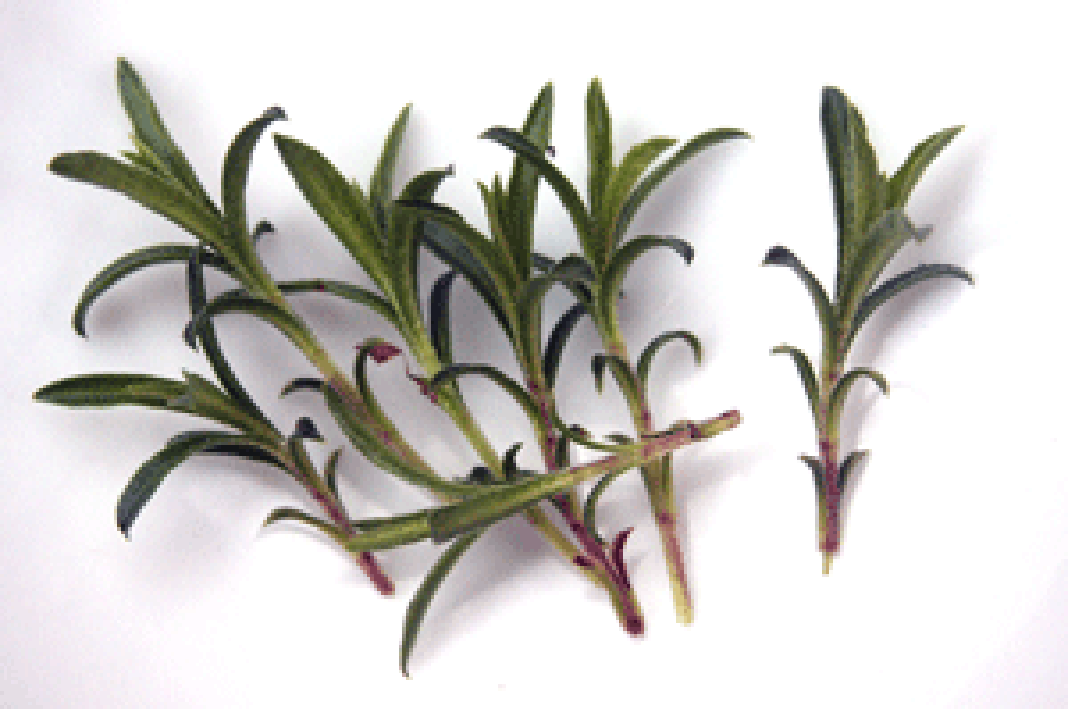 Sprigs of Winter
Savory Satureja
montana.
Sprigs of Winter
Savory Satureja
montana.
Welcome to the summary page for FabulousFusionFood's Herb guide to Winter Savory along with all the Winter Savory containing recipes presented on this site, with 4 recipes in total.
e This is a continuation of an entire series of pages that will, I hope, allow my visitors to better navigate this site. As well as displaying recipes by name, country and region of origin I am now planning a whole series of pages where recipes can be located by meal type and main ingredient. This page gives a listing of all the Cornish recipes added to this site.
These recipes, all contain Winter Savory as a major herb flavouring.
Winter savory (Satureja montana) is a perennial semi-evergreen semi-woody subshrub of the Lamiaceae (mint) family. A native of Southern Europe it grows to about 50 cm tall and bears opposite leaves on the growing parts of the stalks. It is easy to grow, but requires a well-drained soil and direct sunlight for at least six hours a day.
The fresh leaves have a strong spicy flavour (but is less intense than the closely-related summer savory) and make an excellent accompaniment with bean stews and with meats. Generally though it is used as a flavouring for lighter meats, especially fowl such as chicken or turkey. The strong flavour of the leaves become much milder under prolonged cooking so to keep the flavour add the herb near the end of cooking. Chopped winter savory makes an excellent addition to Yorkshire pudding batters lifting the flavour of the dish. As a result it works wonderfully in toad-in-the-hole.
In common with Summer Savory, leaves of good specimens of winter savoury contain up to 2% essential oil, the main component of which is carvacrol, a position isomer of thymol. p-cymene, α-pinene, dipentene, borneol, 1-linalool, terpineol and 1-carvone are also present. However, winter savory is much less pungent in flavour that summer savory.
The English name savory is derived from the Latin satureia (which is also the genus name of the plant). Though the hame has also been influenced by the adjective savoury (meaning 'spicy') via Middle English savery and Old French sarree (both of which derive from Classical Latin sapor (flavour). Winter savory is so named because this plant is evergreen and fresh leaves can be harvested even in the depth of winter.
In modern times this herb is little used; but for centuries it used to be a staple of many herb gardens. The truth is that it is so easy to grow and has a wonderful distinct flavour so there is no reason for you not to introduce it into your own garden.
e This is a continuation of an entire series of pages that will, I hope, allow my visitors to better navigate this site. As well as displaying recipes by name, country and region of origin I am now planning a whole series of pages where recipes can be located by meal type and main ingredient. This page gives a listing of all the Cornish recipes added to this site.
These recipes, all contain Winter Savory as a major herb flavouring.
Winter savory (Satureja montana) is a perennial semi-evergreen semi-woody subshrub of the Lamiaceae (mint) family. A native of Southern Europe it grows to about 50 cm tall and bears opposite leaves on the growing parts of the stalks. It is easy to grow, but requires a well-drained soil and direct sunlight for at least six hours a day.
The fresh leaves have a strong spicy flavour (but is less intense than the closely-related summer savory) and make an excellent accompaniment with bean stews and with meats. Generally though it is used as a flavouring for lighter meats, especially fowl such as chicken or turkey. The strong flavour of the leaves become much milder under prolonged cooking so to keep the flavour add the herb near the end of cooking. Chopped winter savory makes an excellent addition to Yorkshire pudding batters lifting the flavour of the dish. As a result it works wonderfully in toad-in-the-hole.
In common with Summer Savory, leaves of good specimens of winter savoury contain up to 2% essential oil, the main component of which is carvacrol, a position isomer of thymol. p-cymene, α-pinene, dipentene, borneol, 1-linalool, terpineol and 1-carvone are also present. However, winter savory is much less pungent in flavour that summer savory.
The English name savory is derived from the Latin satureia (which is also the genus name of the plant). Though the hame has also been influenced by the adjective savoury (meaning 'spicy') via Middle English savery and Old French sarree (both of which derive from Classical Latin sapor (flavour). Winter savory is so named because this plant is evergreen and fresh leaves can be harvested even in the depth of winter.
In modern times this herb is little used; but for centuries it used to be a staple of many herb gardens. The truth is that it is so easy to grow and has a wonderful distinct flavour so there is no reason for you not to introduce it into your own garden.
The alphabetical list of all Winter Savory recipes on this site follows, (limited to 100 recipes per page). There are 4 recipes in total:
Page 1 of 1
| Game Terrine Origin: Britain | Pressure Cooker Quick Lentil Soup Origin: Britain |
| Ofellae Aprogineo (Starters in the Manner of Wild Boar) Origin: Roman | Sauce Madame Origin: England |
Page 1 of 1